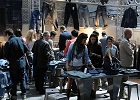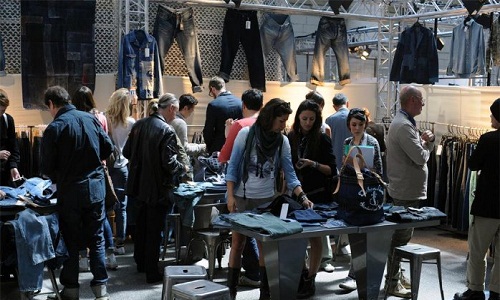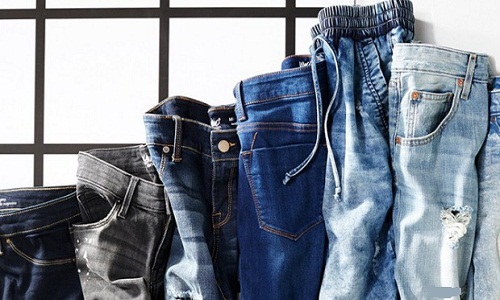FW
India’s textile policy contains a package to boost job creation and promotion of made-ups for the home textile sector, on the lines of the one which was extended to the apparel industry. A Rs 6000 crores special package has been approved for the textile and apparel sector to create one crore new jobs in three years, attracting investments of $11 billion and generating an additional $30 billion in exports. The measures include additional incentives for duty drawback scheme for garments, flexibility in labor laws to increase productivity as well as tax and production incentives for job creation in garment manufacturing.
Free trade agreements will be negotiated with the EU, Australia and Canada. Attempts will be made to sign a separate bilateral agreement with Great Britain. The Indian textile industry is extremely varied, with the hand-spun and hand woven textile sectors at one end of the spectrum with the capital intensive sophisticated mill sector at the other end of the spectrum.
The sector contributes approximately 11 per cent to India’s total exports. It contributes approximately five per cent to India’s gross domestic product and 14 per cent to the overall index of industrial production. The industry is the second largest employer after agriculture.
All business houses should have equal access to city resources, regardless of their size, type or industry, deputy chairman of Ho Chi Minh City’s (HCM) People’s Committee Nguyen Thanh Phong said at a conference in. The city will create favourable conditions and develop a sound investment environment by amending or creating policies to help businesses overcome challenges and take advantage of new opportunities, Phong informed. Phong said startup activity and improvement of competitiveness will be strongly supported by the city. Ideas from enterprises and investors would be welcome as this would help the city and its departments solve social and economic issues. Representatives from companies from different sectors who were present at the conference spoke about ways to help the business community.
Vu Duc Giang, Chairman of the Vietnam Garment and Textile Association opined that the city lacks skilled textile and dye workers, creating challenges for the industry. The shortage of raw material suppliers in the city was another obstacle. He proposed that the city should create a stable regulatory system to help businesses develop.
In recent years, HCM City has worked to create a more favourable investment environment. At present, 180,000 companies operate from HCM City accounting for 31.7 per cent of the total number of companies in the country.
The Gujarat cotton ginning industry is overcrowded. There is overcapacity which prevents even legitimate players and industrialists from earning sufficient returns on the installed capital. Gujarat has a production capacity of around one crore cotton bales but the ginning industry setup has the capacity to process more than three crore cotton bales. This is clearly overcapacity and has left many medium and small scale units in the lurch thus forcing some of them to even go out of operation. Their bank accounts in turn feel the impact of the stress, turning them into non performing assets ultimately.
All this further tends to hurt compliant industrialists who will be unable to make ample profitable returns if the loss making firms continue their business in the already overcrowded market.
Entrepreneurs say the stress should be on reviving the spinning, weaving and garmenting industries more than the ginning industry since these are the sectors which require the services of the ginning industry. They say that if, instead of exporting yarn, the garment industry within India is made capable enough to process the whole cotton ginning industry’s output then not only will it make the Indian garment industry the most self-sufficient sector it will also help the ginning industry recover.
Marketer of innerwear and activewear, Hanesbrands has completed the acquisition of Champion Europe which owns the Champion brand trademark in the Middle East, Africa and Europe. Hanes acquired the privately held Champion Europe, based in Italy, in an all-cash transaction, which it expects to be approximately €200 million. Champion Europe sells Champion athletic apparel wholesale to retailers and directly to consumers via company-owned retail stores. The company's largest wholesale markets are Italy, Greece, Spain and Scandinavia, while the company operates approximately 130 retail stores in Italy and Greece. Champion Europe expects net sales of more than €190 million and operating profit of approximately €15 million in this year.
Construction of a textile training and research technopark has begun within the campus of the Tashkent Institute of Textile and Light Industry. The project, scheduled to be completed in 2018, is being implemented by Ozbekyengilsanoat Joint Stock Company along with the Korean ministry of commerce, industry and energy.
As per the draft plan prepared by the Korean team, the technopark will cover over 4,000 sq metres. Classrooms, conference rooms, exhibition halls, laboratories, offices and other facilities will be available in the high-tech 3-storey building. The 2-storey building will have weaving, knitting, dyeing, and sewing machines installed.
The setting up of the textile technopark would help in the development and implementation of international training and research programs to be implemented in Tashkent Institute of Textile and Light Industry. The technopark will also train Uzbek people in using advanced information and communication technologies, in particular in the field of high value-added products like finished fabrics, sewing and knitted goods.
The setting up of the technopark will help the Uzbek light industry to reach a qualitatively new level of development and improve the training system for the sector, which is one of the main export-oriented industry of the country.
Exporters of the European Union (EU) achieved their best performance for technical textiles and womens wear in 2015. This was revealed by Euratex, the European Apparel and Textile Confederation.
Exports of man-made fibres outside the EU have regained their rate of growth in the last few years and rose 4.5 per cent in value in 2015, Euratex said in a press release.
Though there were some changes in the ranking of the EU’s main customers, the US remained its leading customer. Despite the downward trend in the production volume of thread and yarn in 2015, the volume of exports outside the EU remained unchanged. The value increment noticed (4.8 per cent) stemmed above all from the price of the raw material imports which became more expensive with a weak euro.
"A lot of research and cutting edge innovations are happening in the denim industry to introduce new ideas such as wearable technology in the right products at the right times in to the market. Denim makers are looking at the popularity of athleisure and figuring out how to make certain properties of the comfort category work for the jeans wear market."

A lot of research and cutting edge innovations are happening in the denim industry to introduce new ideas such as wearable technology in the right products at the right times in to the market. Denim makers are looking at the popularity of athleisure and figuring out how to make certain properties of the comfort category work for the jeans wear market.
According to Rachel Lincoln, Manager of Design Services and Innovation, prAna, customers live a very active life, so denim has to work from the trail to the tavern. They hike, climb, bike, and play in our jeans. Customers look for mobility, comfort, abrasion resistance, and longevity in their products and our denim is no exception. Although active bottoms are the most popular type for hanging out at home (31 per cent), jeans are the most popular for running errands (50 per cent), work (32 per cent), and going out to dinner (31 per cent), according to the Cotton Incorporated survey.

According to the NPD Group Inc.’s Consumer Tracking Service, men and women’s US denim jeans sales totaled $13.1 billion in 2015. That’s a 2 per cent decline from the prior year, but a deceleration in the fall off, which was 4 per cent in 2014. Meanwhile, the New York Times recently reported the athleisure market has reached $97 billion, even though it’s a newcomer to the fashion block.
Innovative concepts
Denim has been around since the gold rush days or 1873, to be precise, when Levi Strauss and Jacob Davis got the US patent for riveted denim work pants. After all these years, Levi’s isn’t about to cede the floor. Rather, it’s embarking on innovative concepts like partnering with Google on the tech company’s new Project Jacquard, a program that ‘weaves touch and gesture interactivity into any textile using standard industrial looms.’
Levi’s and Google ATAP (Advanced Technology and Projects group) joined forces to create the Commuter Trucker Jacket. The jacket, which has Google’s Jacquard technology woven in, will be available Spring 2017. The jacket was designed with urban cyclists in mind. Its interactive denim fibers allow wearers to leave their smartphone in the jacket pocket, while maintaining control of, say, their music, phone calls, and maps simply by tapping a smart tag on the jacket sleeve. When the tag is removed, the jacket is completely washable and as durable as regular Levi’s denim.

Levi’s regularly trades on its authenticity and heritage, brand presidentJames Curleigh likes to say that to be successful. Levi’s is a top pick among consumers, giving the company leeway to experiment with out-of-the-box product offerings. Almost 1 in 4 consumers (22 per cent) say they buy Levi’s denim most often, followed by Wrangler (8 per cent), Lee (6 per cent), and American Eagle (3 per cent), according to a research.
While a hands-free mobile experience would likely be welcomed many an urban cyclist, consumers say they’re also looking for multifunctional jeans (86 per cent). Lana Ober, brand relationship manager at Denimology, the denim news and trend resource, says people are now asking for more from their clothing - including denim.
The comfort factor
Ober points to shape retention and full-motion fabric, as athleisure qualities that are being adopted by denim makers. This makes sense as the majority of consumers say fit (75 per cent) and comfort (70 per cent) are the top factors in the denim purchasing decision, according to the data available. These are followed by a ‘flattering look’ (65 per cent), price (59 per cent), quality (56 per cent), and durability (53 per cent).
James Jeans came out with the Twiggy Dancer, Mavi with their FEATHER line, Diesel with Actyvista, AYR with their Flex Tech Jean, 7 For All Mankind with Slim Illusion Luxe, AG with the Contour 360, and J Brand with Hi Def Stretch. These are just are a few examples, ticking off a list of active-inspired offerings. “The Diesel and AYR jeans are actually made to look like workout leggings.
prAna’s Axiom jean is a traditional 5-pocket model with a bit of stretch for mobility and a gusseted inseam for range of motion. The company also has a companion jean that offers abrasion resistance as well as freedom of movement.
Labour leaders in Cambodia have expressed concern over a controversial labour union law that was passed on May 17. Unionists say the new legislation would give the government too much power over their activities and excludes portions of the workforce from labour law protections. They opine it has increased membership thresholds for registration which undermines workers' rights to form new unions and obstructs freedom to organize and mobilize garment workers.
The labor ministry stated in a statement asked unions and employee associations, which have already been registered, as well as those which submitted proposals for registration, to fulfill the conditions and properly implement every obligation as stated in the union law.
It added that the law aims "to ensure the protection of rights and legal interests of every citizen," as well as unions and employers.
Though world cotton acreage is expected to contract 1 per cent to 31 million hectares in 2016/17, the average yield is projected to expand 5 per cent to 735 kg/ha, leading global output to grow 5 per cent to 23 million tons. According to the International Cotton Advisory Committee (ICAC), global cotton consumption is forecast to remain at 23.6 million tons in 2016/17 as low prices for competing fibres make cotton less attractive. ICAC believes while mill use may remain stagnant, world cotton trade volume may increase 1 per cent to 7.4 million tons in 2016/17. In 2016/17, China’s imports are expected to decrease by 8 per cent to 947,000 tons as the Chinese government continues to restrict imports in order to reduce its sizeable stocks of cotton.
While, at the end of 2016/17, global cotton stocks are expected to be down 5 per cent to 20.4 million tons as mills exceed production by 930,000 tons. Here it may be noted that in the 2015/16 season, global cotton output fell 17 per cent to 21.7 million tons, driven by a 9 per cent reduction to 31.1 million hectares in area, while world average yield dropped 9 per cent to 699 kg/ha.
KappAhl has increased the proportion of its sustainability labeled fashion range from 24 to 38 per cent over a 12 month period. KappAhl, a Swedish apparel retailer and fashion brand, has nearly 400 stores in Sweden, Norway, Finland and Poland. Its range includes garments which have been made using organic and Better Cotton Initiative cotton as well as recycled materials in its sustainable range. The brand is online.
Its sustainability work is carried out in everything from materials, water consumption, and reduced use of chemicals to clothes care and textile collecting. Sustainability and profitability are two sides of the same coin for the retailer. By 2020, all cotton in KappAhl's range will be sustainable – produced using identity cottons such as Better Cotton and organic cotton. At present, all cotton in KappAhl’s men’s shirts is produced with organic or Better Cotton while KappAhl’s children's collection Kaxs, is made using organic cotton – as is the baby collection Newbie.
KappAhl does not own any factories, but is one of many customers of independent manufacturers. The company is part of a project which works to improve water, energy and chemical management at its textile supplier production units in India, China, Bangladesh and Turkey.












